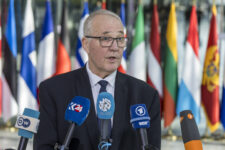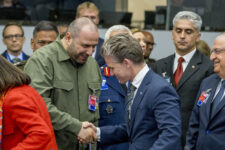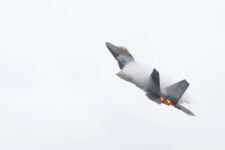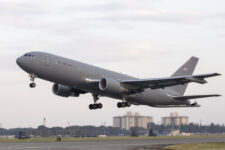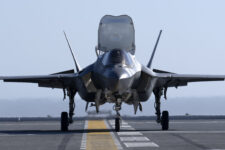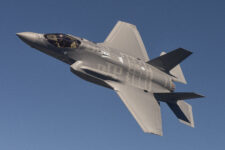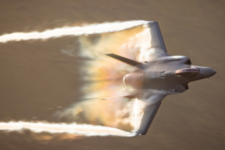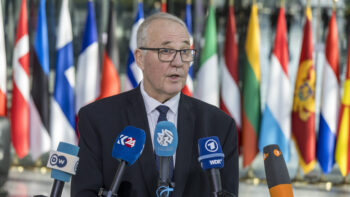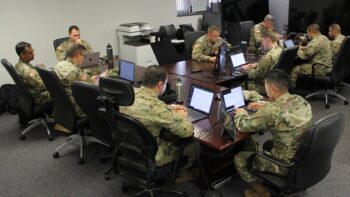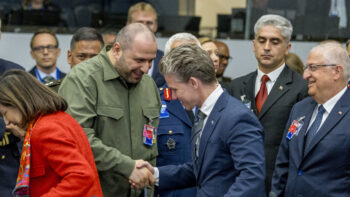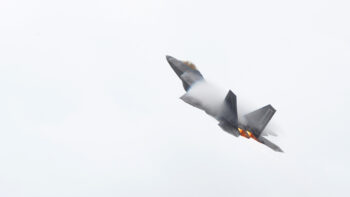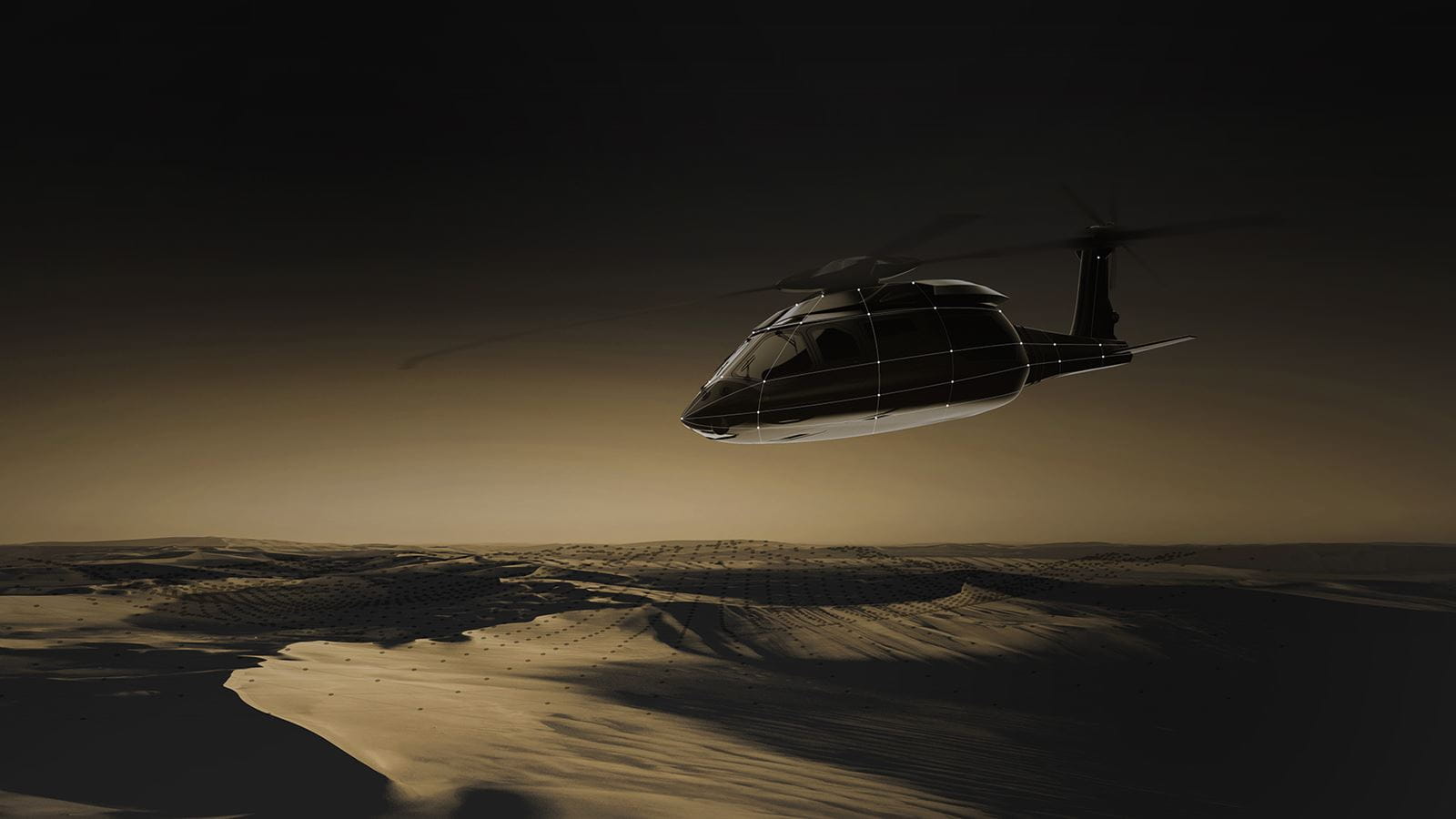
Weight and drag are huge elements that have to be addressed for the two Future Vertical Lift programs to meet their performance goals. (Collins Aerospace graphic)
In this Q&A with Collins Aerospace, we talk with: Harold Tiedeman, technical fellow and Future Vertical Lift chief engineer, who is responsible for technology alignment across Collins Aerospace; and Luke Schmidt, director of Military Strategic Pursuits, who leads the overall FVL program for Collins Aerospace, about how the company and its parent Raytheon Technologies are working together to develop integrated offerings that incorporate the best technology from multiple product lines to deliver transformational technology and platform-wide weight and drag optimization.
Breaking Defense: For this conversation, we’re talking about what Collins calls “unique” and “transformational” integrations. My definition of “unique” is something that hasn’t been done before or that nobody else does. Is that how you mean it?

Harold Tiedeman, technical fellow and Future Vertical Lift chief engineer, Collins Aerospace.
Tiedeman: What we are doing is unique as we’re trying to solve some difficult challenges that are being face by Future Vertical Lift (FVL) and other transformational aviation programs through an integrated and holistic approach. But what we are doing is somewhat unique as we’re trying to solve some difficult challenges that are being faced by Future Vertical Lift (FVL) and other transformational aviation programs through an integrated and holistic approach.
The big challenge on FVL is performance. These aircraft — the Future Long Range Assault Aircraft (FLRAA) and the Future Attack Reconnaissance Aircraft (FARA) — are being asked to do more than has ever been asked before in terms of speed, range, and capability so we need to look at different ways of doing things. To address those challenges and others, Collins has transformed its structure and has created seven strategic technology focus areas, one of which is called Integrated Solutions, in order to leverage the capabilities of all Collins Aerospace business units and Raytheon Technologies.
OEMs have historically procured systems in traditional ways for the last several decades. Now they’re asking us to be innovative and help them solve hard problems. We’re having many discussions with them about the benefits of these integrations and how they transform traditional procurements, cross boundaries, and can be transformational, especially in areas that benefit weight and drag. These are two of the main things that always come out in these discussions.

Luke Schmidt, director of Military Strategic Pursuits, Collins Aerospace.
Schmidt: As Harold said, the traditional procurement model doesn’t support integrated solutions where OEMs typically procure just a flight control computer, an ice protection system, a fire protection system, or a communications system. But what if we looked at those as systems of systems, optimized for reduced weight, drag, volume, and wiring where applicable? That’s truly an integrated system, but you have to start from the beginning. The idea itself is transformational and the actual execution then becomes transformational, as well.
Transformation is not only in the actual systems, but also in the way we’re organized. There’s not a lot of other companies that can do what we do in this space because of the breadth of our product portfolio and how we work across multiple product areas — not only as Collins Aerospace but as a Raytheon Technologies company, as Harold mentioned. Our work here will help serve the aviation industry generally. That’s a key part of what he and I do, which is to look across all of our different systems and teams to help facilitate collaboration. So it’s not only transformative in actual systems but also how we organize our people to make it happen.
Breaking Defense: What is an example of an existing integration from across aerospace and defense?
Tiedeman: One that comes to mind right away is navigation solutions. All those systems were at one time federated. They would have a standalone inertial navigation system (INS) and a standalone GPS system. They would be their own dedicated boxes, and require complex integration at the system level to bring those two together to create a single navigation solution.
Today, almost all the aircraft in the Army and Air Force use what they call an embedded GPS/INS that brings GPS/INS processing into one system. That simplifies system integration and certification, and gets rid of overlapping functions like power supplies and aircraft I/Os. Now you’ve got a much more efficient, integrated solution that provides a better capability than those two things did when they stood alone.
Breaking Defense: Let’s talk more about weight and drag. What specifically are your customers asking for?
Schmidt: If we look at the requirements on FARA, the primes are being asked to fly their aircraft in excess of 180 knots. On FLRAA, they’re being asked to fly 230 to 280 knots from a threshold and objective perspective. So weight and drag are obviously huge elements that have to be addressed for them to be able to accomplish that. Helping with weight and drag has been a major focus of ours for FVL, and then also looking inside at aircraft volumes because there’s only so much space to fit in different systems.
That goes back to our integrated solutions. We’ve looked at our capabilities in lights, antennas, and structures to bring those together in a single aperture. We’ve put a lot of time and energy into figuring out how we can mount an antenna on top of the light to reduce the footprint that it requires on the outside of the aircraft, while not causing interference with the antenna or the light meeting its intended objective. This is an example of what we’ve done to help crack this challenge.
Breaking Defense: Let’s dive into some of the specifics on these integrations, such as the Integrated Light and Antenna for Helicopters that you just mentioned.
Tiedeman: For the Integrated Light and Antenna, we had several conversations with different aircraft OEMs and one of their challenges was trying to find spots on the aircraft to put things. On FARA, for example, there’s approximately 41 different apertures on the aircraft just for communications and sensor applications, not including the places where lights are placed.
When you look at an aircraft, it’s typical that the places where lights are positioned are also strategic places for antennas. So we started thinking: “Is there a way we could bring multiple capabilities to the same space?” In this case, we brought together an anti-collision light and a high-capacity Ku-band antenna that provided the performance the aircraft needed.
The benefit is that now you’ve got fewer apertures as you’re mounting one thing to the aircraft instead of two. Fewer attachment points means lower weight, and fewer bumps on the aircraft means less drag. So that’s one integration that provides multiple benefits in itself.

In this Integrated Light and Antenna for FVL, Collins brought together an anti-collision light and a high-capacity Ku-band antenna that provides the necessary performance. (Collins Aerospace image)
Breaking Defense: Another integration that you’ve developed is called the Aerospace Multifunction Structure for Helicopters. Tell me about that.
Tiedeman: In that case, we had three different businesses that came together to build that structure. Our aerostructures business in Chula Vista, CA, has an out-of-autoclave pressurized molding capability that can form complex aerostructures out of composites. Our interiors business builds carbon nanotube heaters for deicing of leading edges of the aircraft. And our mission systems business has fiber-optic sensing capability that they provide for many functions, including structural health monitoring.
Those are typically separate assemblies that mount to the outside of the structure in the case of heaters or are integrated into the aircraft after the fact in the case of sensors. By applying all those things together, we can do ice protection and temperature sensing with fiber optics so that the amount of energy that you’re putting into the heater can be reduced. That also doubles as a structural health sensor so you can monitor damage or stress on the airframe.
These efficient heaters themselves are lighter weight and amenable to being layered into a normal type composite structure. By putting those things together and avoiding all the typical interface issues, we were able to reduce weight 10-15 percent, and reduce energy that goes into that another 10-20 percent. It’s also lower cost because then you have fewer parts that you have to deal with from different manufacturers.
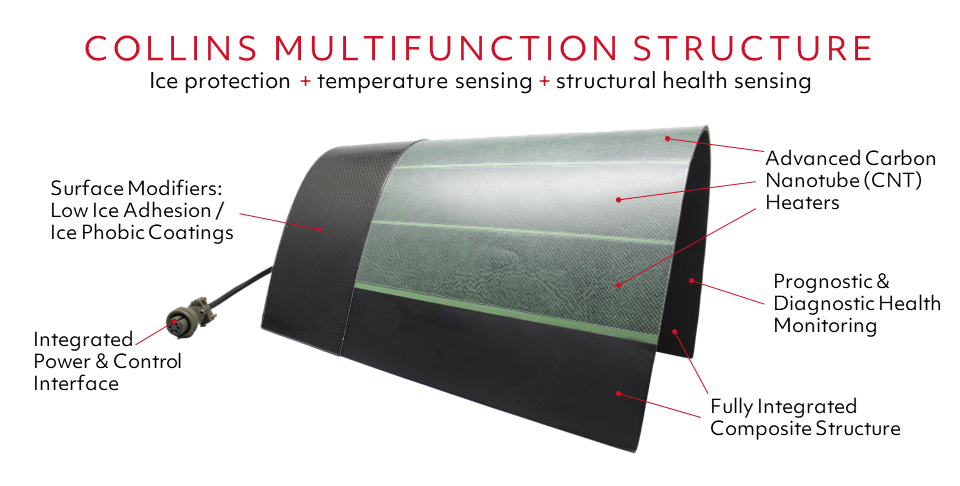
The Collins Aerospace Multifunction Structure for Helicopters reduces weight by 10-15% and energy by 10-20%. (Collins Aerospace graphic)
Breaking Defense: What has changed in the technological world that now allows you to create these integrated systems because I imagine if you could have brought a light and an antenna together 20 years ago, you would’ve done it. In my mind, it probably has a lot to do with digital development. Is that what makes these integrations possible today?
Tiedeman: Definitely the technologies are evolving. A lot of those things that I talked about in the antenna and the structures are fairly newer technologies. The ability to package them together and do things in an integrated way is more possible now than it was before. The digital engineering infrastructure that we have and that we’re constantly improving upon is an enabler for this.
Of the organizations I mentioned earlier that came together for the Aerospace Multifunction Structure for Helicopters, one’s in California, one’s in Ohio, and one’s in Vermont. Once we made the connection that we could do this, the challenge was to get those teams to collaborate. With a digital engineering infrastructure and the tools that we have today to develop the models, we built an integrated environment that made collaboration much easier and more powerful than it would’ve been 10 or 15 years ago.
Schmidt: Another thing is the vision that our leadership has had for how we organize ourselves to enable this — all the way up to Gregory Hayes at the Raytheon Technologies level and Stephen Timm at the Collins level. As Harold just described, we’re all over the map from a geographic perspective here in the U.S. and beyond. So how do we organize?
A key part of that was bringing United Technologies together with Rockwell Collins. The second piece was the merger between UTC and Raytheon Technologies because this goes well beyond Collins and our ability to do some of these collaborations. We’re actively working with our sister divisions Raytheon Intelligence & Space and Raytheon Missiles & Defense, as well as Pratt & Whitney on the engine side to find areas of collaboration.
Our leadership’s vision of bringing these different businesses together has enabled us to do even more in this space over the last two to four years than we had ever thought possible.

The multifunction structure is seen in Collins Aerospace’s ice wind tunnel actually de-icing the structure. (Collins Aerospace photo)
